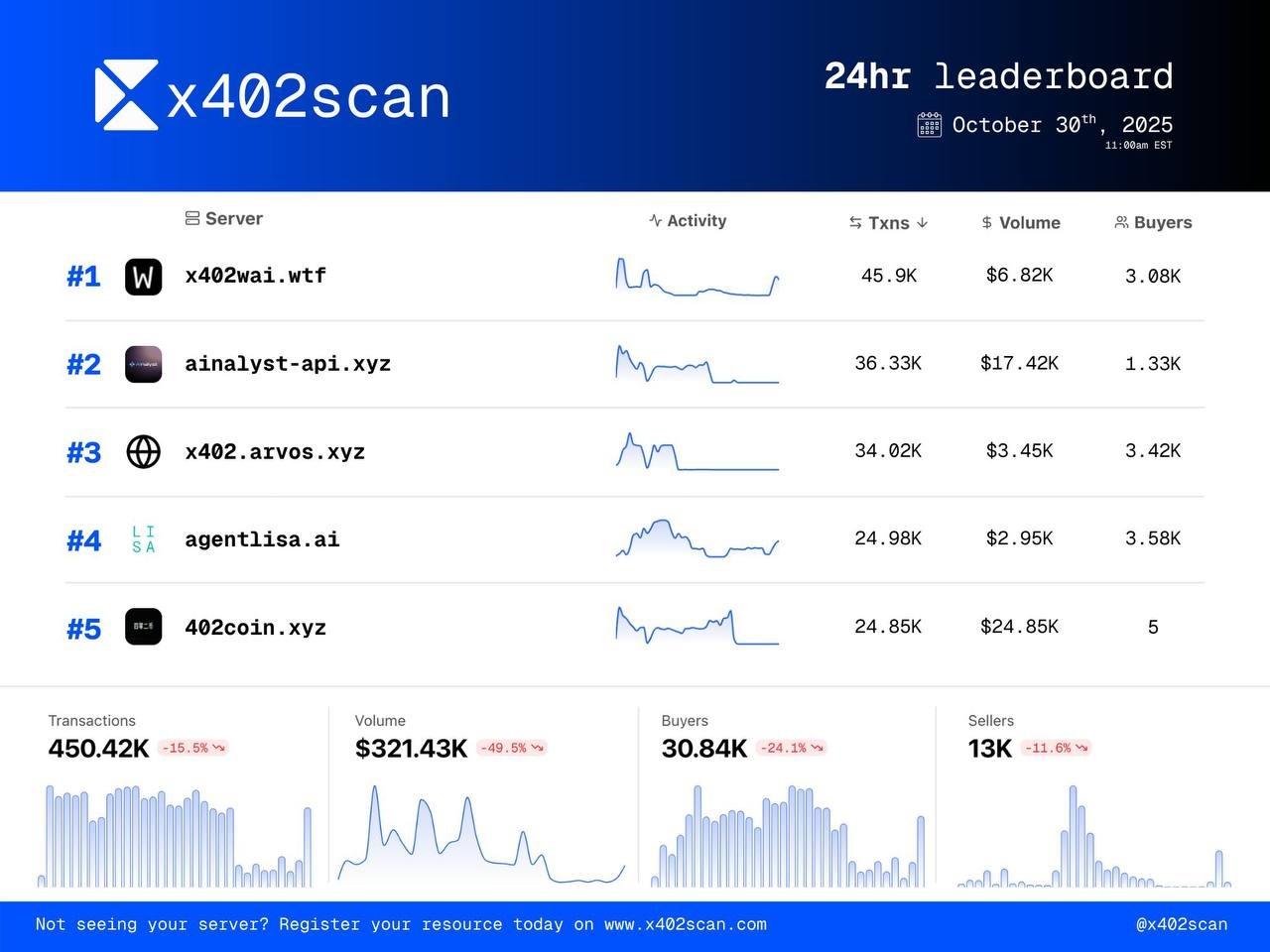TL;DR: AgentLISA achieved #4 on x402scan's 24-hour leaderboard with 3,578 paying developers and $3,100 in daily revenue—up 2,500% from launch two days ago on October 29, 2025. This isn't just traction; it's validation that permissionless, instant-settlement infrastructure is the unlock for autonomous agent adoption. We believe AgentLISA is positioned to become the security layer for the emerging agent-to-agent economy, capturing a disproportionate share of a $2B+ addressable market.

Thesis: The Convergence of Three Irreversible Trends Creates a Category-Defining Opportunity
1. Web3 Security Is Broken by Design—The Market Is Screaming for Solutions
The numbers are unambiguous:
- 200,000 smart contracts deploy monthly; 80% remain unaudited
- $1B+ lost to exploits in 2024 alone
- Traditional audits cost $15,000+ and take 3-5 weeks—economically viable for <1% of protocols
This isn't a temporary gap. It's a structural market failure. The existing security infrastructure—optimized for high-touch, high-margin manual audits—cannot serve the long tail of Web3 builders. 160,000+ contracts deploy annually without security review, representing a $2B+ addressable loss prevention opportunity that incumbents physically cannot capture.
The result? Developers face a brutal choice: ship insecure code or don't ship at all. Neither is acceptable. The market is begging for a solution that makes security economically accessible and operationally frictionless.
2. AI Is Dissolving the Speed-Quality Tradeoff—But Only for Purpose-Built Models
Most "AI security tools" are general-purpose LLMs fine-tuned on audit data. They're fast but brittle, prone to hallucinations, and blind to novel attack patterns. AgentLISA took a different approach: TrustLLM, the first LLM purpose-built for Web3 security, combined with a multi-agent architecture that mirrors how elite security researchers actually work.
The results speak:
- 9/10 OWASP vulnerabilities detected vs. 5/10 for static analyzers
- 100% success rate on complex real-world audits (Arcadia Finance, Virtuals Protocol, Taiko Protocol)
- $7.3M in documented exploits prevented across analyzed projects
- 99% reduction in analysis time (minutes vs. weeks), 90% reduction in cost ($0.50-$5 vs. $15,000+)
But here's what matters: AgentLISA detected critical vulnerabilities that traditional auditors and competitive tools missed. In Arcadia Finance, it caught an accounting flaw that could have resulted in a $3.5M+ exploit. In Virtuals Protocol, it identified incorrect slippage protection during a Code4rena competition. These aren't theoretical edge cases—they're production vulnerabilities in protocols managing real capital.
The technical architecture—specialized agents for reentrancy, property validation, and price manipulation working in coordination—represents genuine innovation, not incremental improvement. And because TrustLLM was built from first principles for security analysis, it can adapt to novel attack vectors as they emerge, while rule-based tools remain static.
3. x402 Is the Missing Infrastructure Layer for the Autonomous Agent Economy
Here's the breakthrough insight: Agents can't use traditional APIs. They can't fill out signup forms, manage API keys, navigate KYC processes, or wait for payment settlement. The friction that humans tolerate is existentially incompatible with autonomous systems.
x402 solves this. HTTP 402—the "Payment Required" status code that's been dormant in the protocol spec since 1997—is finally being activated as infrastructure for machine-to-machine commerce:
- No accounts, no API keys, no KYC: Paste code, pay with USDC on Base, receive results
- ~2 second settlement: Instant access without platform fees or intermediaries
- Programmatically accessible: AI agents can call AgentLISA autonomously
- Transparent pricing: $0.50-$5 per scan based on contract complexity, disclosed upfront
This isn't a payment feature. It's the unlock for agent-native infrastructure. And AgentLISA's #4 ranking on x402scan proves the model works at scale.

Why This Matters: The Unit Economics of Network Effects
Traditional security audits have brutal unit economics: high fixed costs (3-5 week engagements), lumpy revenue (project-based fees), zero marginal scalability (human analysts are the bottleneck). AgentLISA inverts this:
Near-zero marginal cost + usage-based pricing + continuous security = compounding revenue
At $0.50-$5 per scan, AgentLISA unlocks the 99% of Web3 builders who could never afford manual audits. But the real opportunity isn't one-time scans—it's continuous security as infrastructure. Teams can now:
- Scan on every commit via CI/CD integration
- Automatically verify every contract upgrade
- Enable AI agents to self-audit before deployment
- Embed security checks into educational tools and bug bounty workflows
This shifts the product from a service to composable infrastructure—from lumpy project fees to predictable, recurring revenue. The current metrics validate this trajectory:
- 3,578 paying developers in 24 hours (Top 5 on x402scan)
- $3,100 daily revenue (up from $119 at launch—2,500% growth)
- 3,000+ registered users, 500+ premium subscribers
- 14+ blockchain networks supported (Ethereum, BSC, Solana, Base, Arbitrum, Polygon, Optimism, Avalanche)

But here's the flywheel: Every scan improves the model. More developers → more diverse codebases → better detection accuracy → more developers. Late entrants won't just face technology gaps—they'll face data disadvantages that compound over time. By the time a competitor processes millions of contracts to match AgentLISA's sophistication, AgentLISA will have processed millions more.
Distribution as Moat: Workflow Integration Creates Lock-In
AgentLISA isn't competing for developer attention—it's embedding into where developers already work:
- IDE integrations: VSCode, Cursor
- Version control: GitHub
- Automation: CI/CD pipelines
- AI workflows: MCP support for Claude
This matters because security decisions are high-stakes, and switching costs are high. Once a team integrates AgentLISA into their build process, they won't rip it out for a marginal competitor. The workflow disruption and re-training overhead are too painful.
Add x402 integration—which enables permissionless, instant-settlement access—and you have infrastructure that's not just useful but uniquely positioned for the agent-to-agent economy. No competitor can easily replicate this distribution advantage.
Competitive Landscape: First-Mover Advantages Are Compounding
The smart contract security market exhibits winner-take-most dynamics. Developers gravitate toward the most trusted, battle-tested solution. AgentLISA's competitive moat has three layers:
1. Technical Moat
- TrustLLM required deep Web3 security expertise from NTU's Cyber Security Lab—years of R&D that can't be fast-followed
- Multi-agent architecture represents genuine innovation, not incremental improvement
- Data network effects create widening performance gap vs. competitors
2. Distribution Moat
- Workflow integrations (VSCode, GitHub, CI/CD) create lock-in
- x402 protocol integration provides permissionless access competitors can't easily replicate
- Battle-tested credibility on high-profile protocols (Arcadia, Virtuals, Taiko) provides social proof
3. Ecosystem Moat
- 14+ blockchain network support demonstrates platform-agnostic architecture
- Strategic partnerships provide reference customers and ecosystem validation
- Top 5 ranking on x402scan signals market validation and developer trust
The competitive risk? Established firms (CertiK, Trail of Bits, OpenZeppelin) face business model conflict—why cannibalize high-margin audits to compete on price? AI startups face data disadvantages and go-to-market gaps that take years to close. The #4 x402scan ranking despite fierce competition validates that AgentLISA's moat is widening, not narrowing.
Investment Highlights: Why Now, Why AgentLISA
1. Genuine Product-Market Fit
3,578 developers paid for scans in 24 hours. $3,100 daily revenue, up 2,500% from launch. Top 5 on x402scan. This isn't marketing—it's organic adoption driven by genuine value creation.
2. Category-Defining Technology
TrustLLM + multi-agent architecture + formal verification = technical superiority that competitors can't trivially replicate. 9/10 OWASP vulnerabilities detected, 100% success rate on real-world audits, $7.3M+ in documented exploits prevented.
3. Infrastructure Positioning for Agent Economy
x402 integration positions AgentLISA as essential infrastructure for autonomous systems. As AI agents proliferate, the demand for permissionless, instant-settlement services will explode. AgentLISA is years ahead in capturing this wave.
4. Unit Economics That Scale
Near-zero marginal cost + usage-based pricing + continuous security = compounding revenue without linear cost growth. This is infrastructure economics, not service economics.
5. Data Network Effects
Every scan improves the model. First-mover advantage in processing real-world contracts creates data moat that late entrants cannot overcome.
6. Validated by Tier-1 Capital
$12M funding round led by Redpoint Ventures and NGC Ventures validates market opportunity and team execution capability.
The Bottom Line
AgentLISA isn't just solving today's Web3 security problem—it's building the infrastructure layer for the autonomous agent economy. The x402scan #4 ranking isn't a vanity metric; it's proof that permissionless, instant-settlement infrastructure enables entirely new use cases that weren't economically viable before.
The convergence is undeniable: Web3 desperately needs scalable security, AI is finally sophisticated enough to deliver it, and x402 is the protocol layer that makes it accessible to both humans and autonomous systems. AgentLISA sits at the intersection of all three trends—with technical superiority, distribution advantages, and compounding network effects that create a winner-take-most outcome.
We believe AgentLISA will become the default security layer for Web3 development—and the reference implementation for how autonomous agents transact with infrastructure services.
The question isn't whether AgentLISA will capture disproportionate value. It's whether we'll be positioned to benefit when they do.






